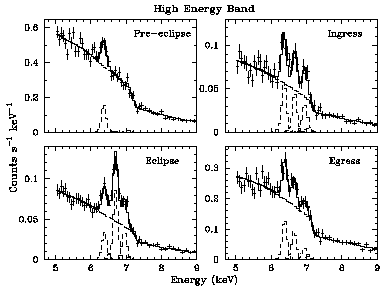Cen X-3

Image Credit: Ebisawa et al 1996, PASJ 48, 425.
The binary X-ray pulsar Cen X-3 was observed over an orbital eclipse, and time variation of the iron line structure was studied. Three iron lines at 6.40, 6.70 and 6.97 keV are clearly resolved. The 6.70 and 6.97 keV lines, which originate in a highly photo-ionized plasma, are most conspicuous during the eclipse, when the neutron star is completely blocked by the companion star. This indicates the photo-ionized plasma is more extended than the size of the companion star. On the other hand, the ratio of the 6.40 keV line flux to the continuum flux (equivalent-width) is nearly invariable. This indicates the 6.4 keV line, which is due to fluorescence from low-ionized material, originates in the vicinity of the neutron star. The figure was taken from Ebisawa, Day et al. (1996), PASJ, in print.
This file was last modified on Friday, 09-Jul-1999 12:04:50 EDT
Curator:
Michael Arida (SP Sys); arida@milkyway.gsfc.nasa.gov
HEASARC Guest Observer Facility
If you have any questions concerning ASCA, visit
our Feedback form.

